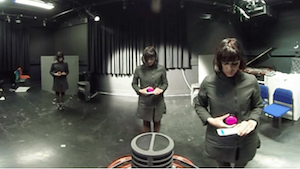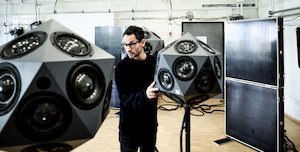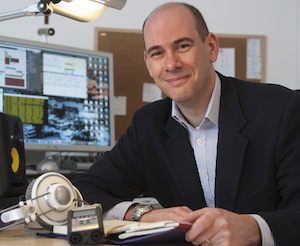Shared Perceptual Spaces in the Sciences and the Arts
Department of Computer and Information Sciences Northumbria University, Newcastle-upon-Tyne, UK
13 December, 2019
Does your work cause you to think about the space around you and how a better understanding of the spaces we inhabit and the acoustic and aesthetic properties of those spaces could lead to improvements in the way you think about your own practice?

On Friday 13th December, the Department of Computer and Information Sciences at Northumbria University, Newcastle upon Tyne, UK will be hosting a 1-day cross-disciplinary workshop, lecture and concert. This will be of interest to people involved in understanding how the space around us impacts us in our daily lives. The workshop will be led by Paul Vickers (Northumbria), Gerriet, K. Sharma (Graz, Austria), and Angela McArthur (Queen Mary, University of London). It follows on from the popular workshop on sonification and sonic interaction design for space run by Paul and Gerriet at Soundstack 2019 on 8 November 2019.
The workshop will feature the IKO icosahedral loudspeaker which generates a stunning 3D sound field. Northumbria University has the only IKO in the UK, so this will be a great opportunity to come and see what IKO can do and the collaborative research opportunities it offers.
WORKSHOP DESCRIPTION
In the broad field of electroacoustic composition and sound design we are dealing for some time now with spatial sound phenomena that not only come from a direction and head for a vanishing point in the concert or studio space. Rather these phenomena have spatial dimensions like proliferation, width, height etc. forming diverse sound masses that can penetrate, layer, move around each other and define by their properties — space itself. Thus, these phenomena are perceived by composers, scientists and audiences causing ‘something’ we call a shared perceptual space (SPS).
Spatial composition has become a subject to academic curricula, workshops and master classes internationally. It is constantly triggering the development and extension of commercial and academic software solutions for the projection, placement and movement of phantom sources, the reproduction of higher order recordings of “natural” sound fields as well as the creation of so called immersive virtual sound environments.
Moreover, as spatial computer music matures and consolidates within institutions and organizations, it is increasingly involving so-called 3D audio systems which can create auditory virtual environments (AVEs). Quite likely in the very near future AVEs will be part of many people’s everyday life, e.g. in cars, working spaces, intelligent homes, concert halls and computer games.
For the composer, the question arises as to what extent a communicable or self-explanatory composition of plastic sound objects is conceptually, theoretically and at all practically possible when faced with changing architectural space situations, different cultural spatial descriptions, and perceptions. It is therefore a matter of finding parameters for an intersubjective space for the perception of three-dimensional sound phenomena. Is there within the field of space-sound composition a space at the place of the music, where the composer’s perception in the compositional process overlaps with both the engineers’ and audience’s perception? Can at least an approximate circumference of an overlap be described? How and from which sides (linguistic, technical, artistic, etc.) can this field be approached?
In this cross-disciplinary workshop and lecture we are going to investigate different uses of the term SPS in a variety of fields as aesthetic strategies, showing that space has become one of the key aspects in all kinds of scientific and artistic, applied and theoretical disciplines. By discussing examples from music, musicology, sociology, philosophy, architecture and linguistics we are trying to extract variables that can help to formulate a perception based framework for a hybrid model of sound as space.
WHEN?
Friday 13 December, 2019. 10.00–18.00 followed by a concert of specially prepared material for the IKO from 19.00–20.00.
WHERE?
The workshop and concert are being held in room C-005 of Ellison Building, Ellison Place, Newcastle on Tyne, NE1 8ST.
Here’s a custom Google Map for the workshop. Note, we’re in C block of Ellison Building.
THE WORKSHOP LEADERS

Angela McArthur’s work explores draws from the technologies, perception and aesthetics of spatial audio to tackle an intersection of the three, with an increasing focus on marine environments, and spatial listening. I’ve been a practising artist, audio engineer and lecturer amongst other things. She is currently working towards my PhD with Becky Stewart and Mark Sandler, both of the Centre for Digital Music and the Media & Arts Tech programme at Queen Mary, University of London. Angela completed her masters in the School of Music & Fine Art at the University of Kent under Claudia Molitor and Sarah Turner. She has lived other places, including New York, Canada, Sydney and Hong Kong.

Gerriet K. Sharma is a composer and sound artist. Within the last 15 years he was deeply involved in spatialization of electroacoustic compositions in Ambisonics and Wave-Field Synthesis and transformation into 3D-sound sculptures.
From 2009 to 2015 he was curator of “signale-graz” concert series for electroacoustic music, algorithmic composition, radio art and performance at the MUMUTH Graz. His works have been presented at various venues and events worldwide, including compositions for the icosahedral loudspeaker (IKO) and loudspeaker hemisphere where presented at Darmstädter Summer Courses 2014, Music Biennale Zagreb 2015, New York City Electroacoustic Music Festival 2009/16, and Sound and Music Conference (SMC) Hamburg 2016. He has received numerous awards and grants including Scholarships by the German Academic Exchange Service (DAAD) in 2007 and 2009. In 2008 he was awarded with the German Sound Art Award. In spring 2014 he was composer in residence at ZKM Karlsruhe/Germany. He was senior researcher and composer within the three year artistic research project “Orchestrating Space by Icosahedral Loudspeaker” (OSIL) funded by the Austrian Science Fund (FWF) with 40 publications, over 20 lectures and 12 internationally premiered compositions. He had been appointed as DAAD Edgar Varèse guest-professor at Electronic Music Studio, Audio communication (AK), TU Berlin for WS 2017/18. Since 2019 he is working on a book on “spatial practices“ and new compositions, exhibitions and a lecture series.

Paul Vickers is a computer scientist and a chartered engineer based in Newcastle-upon-Tyne, UK. His research focuses on data sonification, that is, how sound can be used to communicate data and information. Of particular interest is the role of aesthetics in successful sonification design and how accounts of embodied listening experience can help to explain and understand how people interact with sonic representations of data. Paul finds the space between disciplines to be especially stimulating and has worked with visual artists, sonic artists, and composers as well as with other computer scientists and engineers on a variety of sonification research projects. He is also working on the development of mathematical models to describe the foundations of visualization and sonification to allow comparisons of visualization and sonification processes at the syntactic, semantic, and pragmatic levels. Paul has even performed a stand-up comedy routine based on his sonification research at the Bright Club comedy event. Paul is Associate Professor of Computer Science and Computational Perceptualisation at Northumbria University in Newcastle